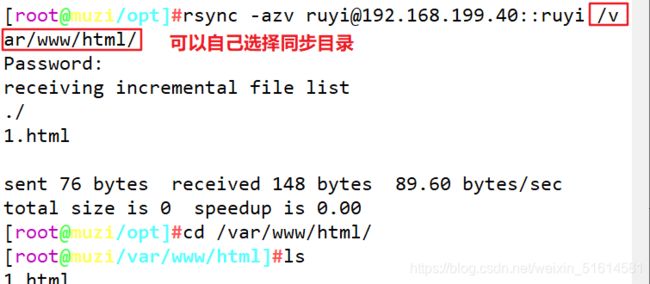rsync+inotify实时同步部署 详解
rsync同步
- 一、rsync同步介绍
- 二、rsync实时同步
-
- 1、定期同步的不足
- 2、实时同步的优点
- 三、关于inotify
-
- 1、Linux内核的inotify机制
- 四、rsync+inotify实时同步
-
- 1、调整inotify内核参数
- 2、安装inotify-tools辅助工具
- 3、通过inodifywait触发rsync同步操作
- 五、实验步骤
-
- 1、配置rsync源服务器
- 2、发起端
- 2、同步方法
- 3、rsync+inotify
一、rsync同步介绍
- 是一个开源的快速备份工具,可以在不同主机之间镜像同步整个目录树,支持增量备份,并保持链接和权限,且采用优化的同步算法,传输前执行压缩,因此非常适用于异地备份、镜像服务器等应用。
二、rsync实时同步
1、定期同步的不足
- 执行备份的时间固定,延迟明显、实时性差
- 当同步原长期不变化时,密集的定期任务是不必要的
2、实时同步的优点
- 一旦同步原出现变化,立即启动备份
- 只要同步原无变化,则不执行备份
三、关于inotify
1、Linux内核的inotify机制
- 从版本2.6.13开始提供
- 可以监控文件系统的变动情况,并作出通知响应
- 辅助软件:inotify-tools
四、rsync+inotify实时同步
1、调整inotify内核参数
- max_queue_events:监控事件队列大小
- max_user_instances:最多监控实例数
- max_user_watches:每个实例最多监控文件数
2、安装inotify-tools辅助工具
- inotifywait:用于持续监控,实时输出结果
- inotifywatch:用于短期监控,任务完成后再出结果
3、通过inodifywait触发rsync同步操作
- 使用while、read持续获取监控结果
- 根据结果可以作进一步判断,决定执行何种操作
五、实验步骤
1、配置rsync源服务器
- 1)关闭防火墙和判断rsync是否安装
systemctl stop firewalld
setenforce 0
rpm -q rsync
- 2)添加/etc/rsync.conf配置文件
vim /etc/rsyncd.conf #添加以下配置项
uid = nobody
gid = nobody
use chroot = yes #禁锢在源目录
address = 192.168.199.40 #监听地址
port 873 #监听端口 tcp/udp 873,可通过cat /etc/services | grep rsync查看
log file = /var/log/rsyncd.log #日志文件位置
pid file = /var/run/rsyncd.pid #存放进程 ID 的文件位置
hosts allow = 192.168.199.0/24 #允许访问的客户机地址
[ruyi] #共享模块名称
path = /var/www/html #源目录的实际路径
comment = Document Root of www.ruyi.com
read only = yes #是否为只读
dont compress = *.gz *.bz2 *.tgz *.zip *.rar *.z #同步时不再压缩的文件类型
auth users = ruyi #授权账户,多个账号以空格分隔
secrets file = /etc/rsyncd_users.db #存放账户信息的数据文件
###如采用匿名的方式,只要将其中的“auth users”和“secrets file”配置项去掉即可。
- 3)为备份账户创建数据文件
vim /etc/rsyncd_users.db
ruyi:123123 #无须建立同名系统用户
chmod 600 /etc/rsyncd_users.db
- 4)保证所有用户对源目录/var/www/html 都有读取权限
yum -y install httpd
chmod +r /var/www/html/
ls -ld /var/www/html/
- 5)启动 rsync 服务程序
rsync --daemon #启动 rsync服务,以独立监听服务的方式(守护进程)运行
netstat -anpt | grep rsync
- 6)关闭 rsync 服务
kill $(cat /var/run/rsyncd.pid)
或者
rm -rf /var/run/rsyncd.pid
2、发起端
基本格式:rsync [选项] 原始位置 目标位置
- 常用选项
-r:递归模式,包含目录及子目录中的所有文件
-l:对于符号链接文件任然复制为符号链接文件
-v:显示同步过程的详细信息
-z:在传输文件时进行压缩
-a:归档模式,保留文件的权限、属性等信息,等同于组合选项“-rlptgoD”
-p:保留文件的权限标记
-t:保留文件的时间标记
-g:保留文件的属组标记(仅超级用户使用)
-o:保留文件的属主标记(仅超级用户使用)
-H:保留硬连接文件
-A:保留ACL属性信息
-D:保留设备文件及其他特殊文件
–delete:产出目标位置有而原始位置没有的文件
–checksum:根据校验和(而不是文件大小、修改时间)来决定是否跳过文件
2、同步方法
- 1)将指定的资源下载到本地/opt目录下进行备份。
rsync -avz [email protected]::ruyi /opt #密码abc123
或者
rsync -avz rsync://[email protected]/ruyi /opt
- 2)免交互格式设置
echo "123123" > /etc/server.pass
chmod 600 /etc/server.pass
crontab -e
30 22 * * * /usr/bin/rsync -az --delete --password-file=/etc/server.pass [email protected]::ruyi /opt/
3、rsync+inotify
- 使用inotify通知接口,可以用来监控文件系统的各种变化情况,如文件存取、删除、移动、修改等。利用这一机制,可以非常方便地实现文件异动告警、增量备份,并针对目录或文件的变化及时作出响应。
- 将inotify机制与rsync工具相结合,可以实现触发式备份(实时同步),即只要原始位置的文档发生变化,则立即启动增量备份操作;否则处于静默等待状态。
- 因为 inotify 通知机制由 Linux 内核提供,因此主要做本机监控,在触发式备份中应用时更适合上行同步。
1)修改rsync源服务器配置文件
vim /etc/rsyncd.conf
......
read only = no #关闭只读,上行同步需要可以写
kill $(cat /var/run/rsyncd.pid)
或者
rm -rf /var/run/rsyncd.pid
rsync --daemon
netstat -anpt | grep rsync
chmod 777 /var/www/html/
2)调整 inotify 内核参数(在客户端执行)
- 在Linux内核中,默认的inotify机制提供了三个调控参数:max_queue_events(监控事件队列,默认值为16384)、max_user_instances(最多监控实例数,默认值为128)、max_user_watches(每个实例最多监控文件数,默认值为8192)。当要监控的目录、文件数量较多或者变化较频繁时,建议加大这三个参数的值。
cat /proc/sys/fs/inotify/max_queued_events
cat /proc/sys/fs/inotify/max_user_instances
cat /proc/sys/fs/inotify/max_user_watches
vim /etc/sysctl.conf
fs.inotify.max_queued_events = 16384
fs.inotify.max_user_instances = 1024
fs.inotify.max_user_watches = 1048576
sysctl -p
3)安装 inotify-tools(客户端)
-
用 inotify 机制还需要安装 inotify-tools,以便提供 inotifywait、inotifywatch 辅助工具程序。
-
notifywait:可监控modify(修改)、create(创建)、move(移动)、delete(删除)、attrib(属性更改)等各种事件,一有变动立即输出结果。
-
inotifywatch:可用来收集文件系统变动情况,并在运行结束后输出汇总的变化情况。
yum -y install gcc gcc-c++ make
tar zxvf inotify-tools-3.14.tar.gz -C /opt/
cd /opt/inotify-tools-3.14
./configure
make && make install
4)执行“inotifywait”命令,然后在另一个终端向/var/www/html (客户端)
目录下添加文件、移动文件,跟踪屏幕输出结果。
inotifywait -mrq -e modify,create,move,delete /var/www/html
#选项“-e”:用来指定要监控哪些事件
#选项“-m”:表示持续监控
#选项“-r”:表示递归整个目录
#选项“-q”:简化输出信息
5)在另外一个终端编写触发式同步脚本
vim /opt/inotify.sh
#!/bin/bash
INOTIFY_CMD="inotifywait -mrq -e modify,create,attrib,move,delete /var/www/html/"
RSYNC_CMD="rsync -azH --delete --password-file=/etc/server.pass /var/www/html/ [email protected]::ruyi/"
$INOTIFY_CMD | while read DIRECTORY EVENT FILE
##while判断是否接收到监控记录
do
if [ $(pgrep rsync | wc -l) -le 0 ] ; then
$RSYNC_CMD
fi
done
6)赋权
chmod +x /opt/inotify.sh
chmod 777 /var/www/html/
chmod +x /etc/rc.d/rc.local
echo '/opt/inotify.sh' >> /etc/rc.d/rc.local #加入开机自动执行















